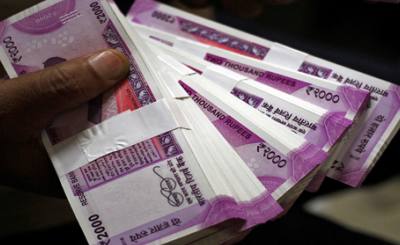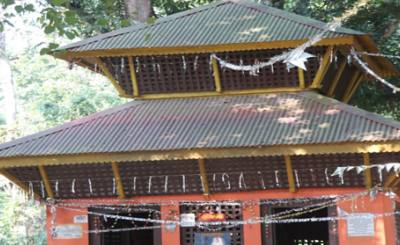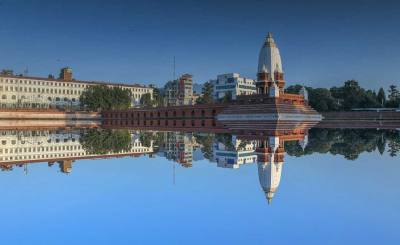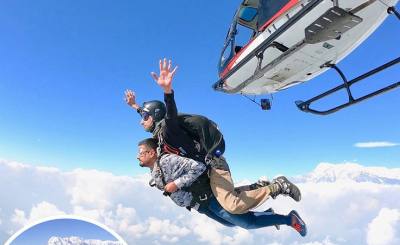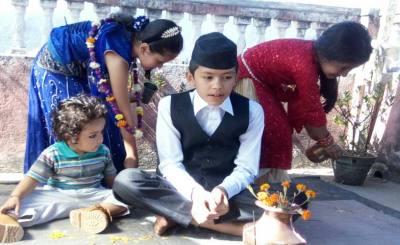Pashupatinath Temple is the most important sacred site for Hindu devotees around the world. Listed in the UNESCO world heritage site, this monument has drawn thousands of devotees around the continents, especially more from India. This site has been founded in the 16th century and is dedicated to Lord Shiva, who is regarded as the most powerful God in Hinduism. The pagoda-style temple of Pashupatinath is located beside the holy Bagmati River. Hundreds of big and small temples with the unique medieval main temple. The dead body burning culture of Hinduism can be seen that takes place beside the River, which is known as Ghat (crematorium). Every year, during the Mahashivaratri festival, devotees pay homage with a pilgrimage tour to Pashupatinath.

Boudhanath Stupa lies in the heart of Kathmandu city that has pulled travelers around the world with its unique and giant form. Listed in the UNESCO world heritage Site, Boudhanath has become a spiritual center for all religious devotees, especially Buddhist pilgrimage seekers. Boudhanath Stupa Tour offers the fabulous experience of spinning the prayer wheels, which is accompanied by fluttering prayer flags over your head. With the entrance of the Tibetan refugees in the 1950s, Tibetan Buddhism sprung in Nepal and since then Boudhanath Stupa came into existence. The white mound looms 36 meters overhead with Budhha's eyes on the golden top that blesses you for peace and prosperity. Boudhanath Stupa is surrounded by several Tibetan refugee settlements, souvenir shops, restaurants, and monasteries.

Swayambhunath :
Swayambhunath is a beautiful Buddhist Stupa on the hillside in the Kathmandu valley. It is often adorned with fluttering Buddhist prayer flags as it is a famous pilgrimage site in Nepal. One of the UNESCO world heritage sites in Kathmandu, Swayambhunath is a 5th-century monument that has got a fabulous vibe emerging through the painted eyes of Buddha. Swayambhunath tour offers an excellent panoramic view of the valley. It is believed that this sacred place is a self-sprung destination that has transformed from the lotus flower, which was on the Lake that had prevailed throughout the valley. Devotees love to walk through the steep stone staircases, which symbolize the journey to heaven and reaching the top of the hillside, you go on spinning the prayer wheels that offer deep spiritual relaxation. Due to the innumerable monkeys hanging around the site, Swayambhunath is more popular as a Monkey Temple.

Kathmandu’s Durbar Square is one of the UNESCO-listed world heritage sites and the Durbar squares in the Kathmandu valley. This medieval palace was once the abode of the Royal family. Constructed in the 16th century, it has got two fine courtyards, which are also known as chowk. The palace is decorated with elaborately-carved wooden windows and panels and houses the King Tribhuwan Memorial Museum, dedicated to the monarch who opened up Nepal to the outside world. The stone and wooden craftsmanship have disclosed the rich art of the ancient period that signifies the importance of the tour to Kathmandu Durbar Square. The Kumari Chowk is a central attraction for travelers around the world to explore the lifestyles of Kumari, who is believed to be the reincarnation of the goddess. She is highly praised and worshipped during the festivals and on some special occasions. Kathmandu Durbar Square Tour is easy to access as it lies at the heart of Kathmandu and for this reason; it is one of the most visiting sites.

Patan Durbar Square:
Patan Durbar Square is popular for artistic creation, which is a UNESCO-listed world heritage site. Patan, the city itself known as the city of arts, is located about half an hour's driving distance from Thamel. It is fragmented from other cities due to its substantive architectural and ancient masterpieces. With the ancient temples that carry amazing stone and wooden sculptures, The Patan Durbar Square tour offers outstanding memories. Krishna Mandir of Patan is the most renowned temple, dedicated to Lord Krishna that was built in the early 17th century. Religious harmony can be seen here as it has got the Golden temple, which is a Buddhist monastery. You can explore various Buddha images illustrated on the walls. Bhimsen Temple, Manga Hiti, Vishwanath Temple, Jagannarayan Temple, Golden Temple, and others are popular temples around Durbar Square.
Bhaktapur Durbar Square:
Bhaktapur Durbar Square has been widespread with its unique and dazzling pagoda and Shikhara-style temples. It is a place, where you can explore the exciting and ancient arts and architecture that are carved in the woods and stones. Not only the temples but also the ancient palace, museum, sculptures of deities, and the overall surroundings disclose the fact that has to be admired. 55 window palace, Dattatraya temple (5 stories temple built in the early 15th century, which is the tallest temple in the Kathmandu valley), Golden gate (the most beautiful and richly molded specimen of its kind that has been surmounted by a figure of the goddess Kali and Garuda), Pool, Pottery Square and many more attractions that will keep the travelers busy for the whole day.

Nagarkot:
Nagarkot is the renowned hillside tourist destination above Bhaktapur, which is about 1.5 hour's drive from Kathmandu. It is extremely popular for the outstanding Himalayan views that can be seen at your eye level, including Mt. Everest, Langtang region, Tibetan peaks, and many more. The sunrise view over the dramatic peaks has allured travelers around the world. From the basic lodge to the world-class standard hotels serve for the accommodation in Nagarkot. It is also one of the best honeymoon spots in Nepal.

Pokhara:
Pokhara is a city of natural wonders that have been surrounded by Lakes. It has become a tourist hub since tourism was introduced in Nepal. The magnificent Annapurna Himalayas, Dhaulagiri, and Manaslu can be explored closely from Pokhara for which the Pokhara Tour is an unavoidable part of Tours in Nepal. All the tourists who come to Nepal, prefer to visit Pokhara as it is also the gateway to the Annapurna Trekking.

DAVI'S FALL:
The cascading waterfall offers beautiful scenery during the tour in Pokhara. At various points, it disappears and again appears as a waterfall. The water is an outlet of the Phewa Lake. David Falls was named for this waterfall as David (the real person) disappeared after he and his friend Devin were washed away by the water unknowingly after the doors of the dam opened up to reduce the water level.

GUPTESHWOR MAHADEV CAVE:
Gupteshwor Mahadev cave is an attractive cave located in the immaculate location of Pokhara, a world-famous tourist destination in western Nepal. Ancestors called this place desolate Khatri Tara. The location, wonders, and spiritual values have made the visit to Gupteshor cave extremely popular among visitors. Gupteshwor Mahadev Cave contains a huge stalagmite worshiped as a Shiva lingam. The standard ticket only covers the temple, but you can pay extra to clamber through a low tunnel behind the shrine, emerging in a damp cavern behind the thundering waters of Devi’s Falls.
PHEWA LAKE:
Phewa lake is the most popular lake in Nepal, which is situated at the heart of Pokhara city. It is spread in 41/2 km in length and 200 M to 1 km in width. In the middle part of the Lake, the renowned Taal Barahi temple lies. The temple is a spiritual center for the Hindu devotees, which is visited by thousands of devotees every year. Boating in Phewa Lake is an incredible experience in Pokhara that also offers a dazzling view of Mt. Fishtail (also known as Machhapuchhre).

SETI RIVER GORGE:
Seti River, on its literal meaning of milky white River, originates from Mt. Fishtail and has flowed making an adventurous gorge that can be explored in one part of Pokhara. It disappears making a natural tunnel and reappears in another part. This natural mystery has become a tourist (both internal and external) attraction that you can only hear the gushing noise of the River.

VINDHIYAVASINI TEMPLE:
If you want to see the way Hindu devotees pay their homage as a pilgrimage tour, The Vindhyavasini temple is the best choice to visit. It is located at the hilltop that has been marked as one of the best pilgrimage spots in Pokhara to visit and worship that is believed to fulfill the wishes you have.

INTERNATIONAL MOUNTAIN MUSEUM:
The International Mountain Museum is an information center for those who are curious to know/see the mountaineering things and its detailed information. The museum has been opened on the 50th anniversary of the first ascent of Mt. Everest (8848 meters) by Tenzing Norgay Sherpa and Edmund Hillary. Climbing steps, equipment, use of oxygen, challenges, and other aspects are exhibited in the museum.
BARAHI TEMPLE:
The Barahi Temple is the most important monument in Pokhara. Built almost in the center of Fewa Lake, this two-storied pagoda is dedicated to the boar manifestation of Ajima, the protector’s deity representing the female force Shakti.
KARMA DUBGYU CHOKING NYESHANG MONASTERY:
Karma Dubgyu Choling Nyeshang Monastery is set on the top of the hill and gazes down at the sprawling town. The peace and tranquility reign here under the shadows of the immense Buddha figure. The monks inside the monastery are extremely willing to help with prayers and information that makes your day outstanding and wonderfully blessed.
MAHENDRA CAVE / BAT CAVE:
The Mahendra Cave attracts visitors during their stay in Pokhara. This large limestone cave is locally known as the House of Bats. This cave is full of stalactite and stalagmite formations. The exact size of the cave complex cannot be decided. This cave has offered a mystery about its size and the formations, but the travelers just enjoy exploring.
MANAKAMANA:
Manakamana temple is one of the most sacred sites in Nepal that lies in the Gorkha district of western Nepal. The cable car has been made easily accessible from the Prithvi Highway to the temple. It is a temple, where the cock and goat are slaughtered and offered blood to the goddess. It is believed that if you visit this temple, all your wishes will be fulfilled. The story behind the establishment of the Manakamana temple goes back to the 17th century during the reign of King Ram Shah.
One day the King found his queen as goddess following the revelation he mentioned it to his queen and suddenly died, he was cremated and his queen committed Sati on his funeral pyre as per the custom, she consoled her lamenting devotee Lakhan saying she would reappear near his home, six months later a farmer plowing his field hit a stone, and on cleaving it blood and milk flowed from the stone which ceased to flow only when Lakhan worshipped it with his tantric knowledge. The site became the foundation of the present shrine and the present pujari (priest) is the 17th generation descendant of Lakhan Thapa. The shrine of Manakamana renovated many times over the centuries has a four-storied pagoda-style roof with an entrance from the South-West. The priest performs daily Pooja and rituals in the temple behind closed doors by offering oranges, rice, red powder (vermilion), and strips of cloth to the deities.

MUKTINATH:
Muktinath is a sacred pilgrimage site in the Mustang region of Nepal, which is a place that you must go there once in your lifetime. It is an important site for both Hindu and Buddhists. Muktinath temple lies approximately about 18 km northeast of Jomsom at an altitude of (3749 M-12184 Ft), which is the main shrine, dedicated to Lord Vishnu. The Holy Lake in Muktinath, 108 water sprouts, and the temple itself are the subjects that keep you busy in worshipping, holy bath, and others. The route to Muktinath temple goes along the Kali Gandaki River, where the precious stone, Shaligrama can be found. Several options are available for the trip to Muktinath: by road, by trek via the Annapurna region, and by helicopter tour. All options are available with Blue Himalaya Tours and Travels.

Chitwan Jungle Safari:
At the foot of the Himalayas, Chitwan is one of the few remaining undisturbed vestiges of the Terai region, which formerly extended over the foothills of India and Nepal. It particularly has rich flora and fauna and one of the last populations of single-horned Asiatic rhinoceros dwell freely in this park and it is also one of the last refuges of the magnificent Royal Bengal Tiger. Surrounding Chitwan National Park in southern Nepal is one of the best planned and most intelligently developed tourist areas of Nepal. Though the Terai is certainly not what it once was the preserved portion within the Chitwan National Park is still a treat for animal lovers the Royal Bengal Tigers roam the region, the one-horned rhinoceros can be seen charging through the under the bush, feeding and even courting the Rapti river has been dammed to form a man-made lake called Lamital where aquatic birds, kingfishers, woodpeckers, and marsh muggers can be seen in abundance. Elephant grass five to six feet tall provide excellent camouflage for the animals, the grass also serves as food for the gaur (local bison) rhino, and other herbivores. Once a year local people are allowed into the safari park area to cut grass, the grass is also stored as food for the domestic animals during dry seasons, it is also dried and used to thatch roofs.

Lumbini Gautam Buddha Birthplace:
Lumbini is a sacred Buddhist site in Nepal, which is the birthplace of Lord Buddha. The world recognizes Lumbini for this quality that has born a highly precious soul, who has spread the message of peace and wisdom throughout the world. The Lumbini is a UNESCO-listed world heritage site in Nepal and is adored for its dimensional features. The main attraction at Lumbini is the Sacred Garden, which is spread out over 8 sq km and contains all of the treasures of this historical area. The Mayadevi temple is the main attraction for pilgrims and archaeologists alike. Here we find a bas relief that shows Mayadevi, the Buddha’s mother, giving birth to him. Standing west of the Mayadevi shrine is the oldest monument in Nepal, the Ashoka Pillar. The pillar was erected by Emperor Ashoka in order to commemorate his pilgrimage to the sacred site.

Janakpur Sita temple:
Janakpur is a famous pilgrimage site in low land, the Terai region of Nepal. Goddess Sita was born in Janakpur and it is also a place where Sita got married to Lord Rama. Sita was a daughter of King Janak, who found her in a furrow of a field. The marriage between Rama and Sita marked a highly renowned ceremony, which is still celebrated on the same date in Nepal and India. One interesting story behind the marriage of Rama from Ayodhya and Sita from Janakpur is that the king announced that she could be married by whoever was able to string the divine bow of Shiva. Though many royal suitors tried, only Lord Rama, the prince of Ayodhya, was successful. And not only did he string the bow, but he also snapped it in two. Thus, Lord Rama won the hand of Sita.

Trip Highlights of Nepal City Tour
Kathmandu:
Lalitpur:
Bhaktapur:
Nagarkot:
Dhulikhel:
Pokhara:
Lumbini:
Chitwan:
Janakpur:




















